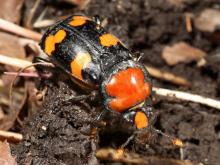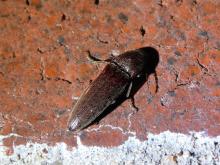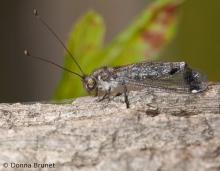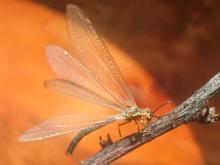Land Invertebrates
Media

Species Types
Scientific Name
Nearly 500 species in North America north of Mexico
Description
Velvet ants are not true ants. True ants are social insects, while velvet ants are a group of solitary wasps. Female velvet ants are wingless throughout their lives; males are winged.
Media

Species Types
Scientific Name
Nicrophorus americanus
Description
The American burying beetle is endangered statewide and threatened nationally. Restoration efforts are under way. This brightly patterned beetle specializes in cleaning carrion from the landscape, burying dead mice, birds, and other creatures.
Media

Species Types
Scientific Name
More than 400 species in North America north of Mexico
Description
The name is a warning: blister beetles are famous for their chemical defenses. Beetles in this family can exude an oil that can cause a person’s skin to blister.
Media

Species Types
Scientific Name
Approximately 1,000 species in North America
Description
Their streamlined shape is distinctive, but the behavior of click beetles is even more unique: Placed on their backs, these beetles flip suddenly into the air with an audible click.
Media

Species Types
Scientific Name
Tabanus, Chrysops, and related genera
Description
Meet the horse fly: Stealthily, one will land on your back, slice your skin, and lap your blood. By the time it starts to hurt and you swat at it, the painful, itchy welt is rising.
Media

Species Types
Scientific Name
Sphex pensylvanicus
Description
A strikingly large black wasp with smoky black wings that shine with blue iridescence, the great black wasp is often seen busily eating nectar and pollen from flowers in summertime.
Media

Species Types
Scientific Name
Nearly 500 species in North America north of Mexico
Description
Soldier beetles are most often seen on flowers. Many species in this family are pollinators. Yellow, orange, and red are their most common colors, besides black and brown.
Media

Species Types
Scientific Name
8 species in North America north of Mexico
Description
An owlfly looks like a dragonfly with a butterfly’s head. Dragonfly shaped and sized, they have long, clubbed antennae and large, bulging eyes. Look for them in summertime dusks and evenings.
Media

Species Types
Scientific Name
About 85 species in North America north of Mexico
Description
Green lacewings are delicate insects whose larvae are ravenous predators of aphids. This makes the lacewing a friend to gardeners!
Media

Species Types
Scientific Name
More than 100 species in North America north of Mexico
Description
Adult antlions look something like drab damselflies. These insects are most familiar in their immature stages, called doodlebugs, which create pits in sand for trapping ants.
See Also



Media

Species Types
Scientific Name
Cisseps fulvicollis
Description
The yellow-collared scape moth is more often “orange-collared.” And whether you think it looks more like a firefly or a wasp, it’s still a moth!
Media

Species Types
Scientific Name
Nearly 150 species in North America north of Mexico
Description
Slim, delicate plume moths are instantly recognizable by their T-shaped silhouette, long legs, and muted shades of tan and brown. It can be hard to separate the various species.
Media

Species Types
Scientific Name
Pyrrharctia isabella
Description
Not many people know the adult Isabella tiger moth when they see one, but we’re all acquainted with its caterpillar, the woolly worm, or woolly bear.
About Land Invertebrates in Missouri
Invertebrates are animals without backbones, including earthworms, slugs, snails, and arthropods. Arthropods—invertebrates with “jointed legs” — are a group of invertebrates that includes crayfish, shrimp, millipedes, centipedes, mites, spiders, and insects. There may be as many as 10 million species of insects alive on earth today, and they probably constitute more than 90 percent all animal species.





















